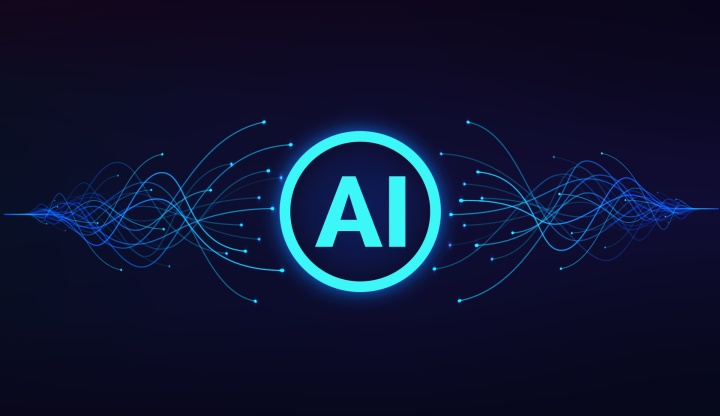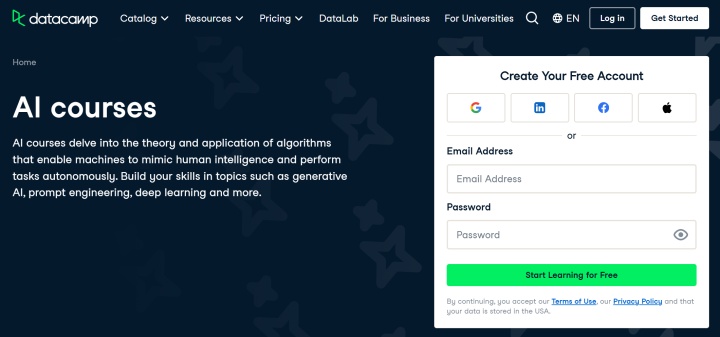Understanding AI: How to Learn the Basics of Artificial Intelligence
The widespread use of artificial intelligence is a significant tech trend of the 2020s. AI technologies are now actively used in many industries, facilitating, accelerating, and optimizing human work. Understanding the key principles of artificial intelligence and the ability to interact with it are becoming the most important skills for many specialists. In this article, we have prepared an AI learning roadmap for you, which will help you master such a promising direction for professional or personal purposes.
What is Artificial Intelligence
It is worth starting your acquaintance with artificial intelligence with a brief introduction to AI. This provides a fundamental insight into the core nature of the phenomenon.
Artificial intelligence (AI) is a set of technologies that allows creating services and systems that imitate human thinking. Programs with AI capabilities can perform complex tasks that require certain intellectual abilities. They can solve problems, search and analyze data, write and translate texts, generate program code, and more.
Modern AI technologies are based on machine learning (ML) algorithms, which enable programs (called models) to make decisions, create predictions, or perform other actions.
One of the key AI fundamentals is neural networks. These are multifunctional ML algorithms. Their architecture enables the processing of vast datasets to uncover patterns, trends, and connections.

Getting to know its main functions and features will help expand your understanding of AI. These include:
- Natural language processing (NLP). This is among the most in-demand capabilities of artificial intelligence. It enables programs to analyze, generate, check, and edit text and translate it into multiple languages.
- Planning and decision-making. Including in conditions of uncertainty or the unknown. AI processes various outcomes and calculates the probability for each of them.
- Robotic process automation (RPA). AI-driven software bots help to automate a wide range of routine tasks. These include sorting and classifying data, collecting statistics, compiling reports, and more.
- Speech recognition and generation. Artificial intelligence recognizes human speech in different languages and converts it into text format. AI systems effectively perform this task in reverse order. They can also generate speech based on the text loaded into them.
- Data analysis and predictive modeling. AI algorithms thoroughly examine data to detect meaningful patterns. Based on the processed information, they generate personalized forecasts and insights.
- Social interaction. Chatbots and virtual assistants commonly utilize AI models. They respond to user requests, recognize their intentions, and can even simulate emotions and a sense of humor.
Key Concepts and Terminology
Understanding AI key concepts and basic terminology helps you navigate the principles of how intelligent systems work. Key technologies include machine and deep learning, generative models, AI agents, and large language models. Let's look at what each of these concepts is.
Machine Learning (ML)
ML is one of the fundamental technologies for the development of artificial intelligence. It allows training algorithms (models) to independently perform certain actions or make conclusions/forecasts based on input data.
Today, there are a number of machine learning methods: logistic and linear regression, decision trees, clustering, and more. Reinforcement learning occupies a special place. Through it, the model solves problems in practice, learning from its own mistakes.
Deep Learning (DL)
DL, as well as ML, refers to the basics of artificial intelligence. This technology is used to create ML models of increased complexity, capable of performing a wide range of intellectual tasks. Multilayer neural networks are used for this. Their architecture mimics the neural networks found in the human brain.
The main distinguishing feature of DL models is their ability to learn complex representations and patterns directly from raw data, often without human feature engineering. This allows them to adapt to new tasks and improve results without the need for manual intervention.
Generative AI
Generative AI stands as one of the leading-edge technologies currently available. It can process and analyze data and create new information based on it.
- Automate the work of an online store or landing
- Empower through integration
- Don't spend money on programmers and integrators
- Save time by automating routine tasks
Typical tasks of generative AI: writing and translating texts, generating images, audio and video content, program code, etc. Multifunctional transformer models are used for these purposes. They form the basis of most popular AI systems (ChatGPT, Claude, Midjourney, Google Gemini, and Microsoft Copilot).
AI Agent
Among the basic AI terms for beginners, "AI agent" is often encountered. It is an AI-powered application created to carry out particular functions.
AI agents help modern businesses optimize and automate various processes. Key areas of their application include data collection and processing, customer communications, predictive analytics, and autonomous vehicle management.
Large Language Model (LLM)
Large Language Models (LLMs) are deep learning algorithms developed based on particularly large data sets. These include transformer models GPT, Gemini, and others.
LLMs differ from conventional ML models by a multitude of parameters (from tens of millions to a trillion) and the colossal volume of data they are trained on. These models can handle and produce vast volumes of data. In addition, they perform the most complex analytical tasks.
Essential Resources for Beginners
For those just starting out in AI, finding reliable, high-quality sources of knowledge is especially important. Here is a selection of the best resources to learn AI that will help you master this rapidly developing field. Among them are learning platforms, courses, and communities covering different aspects of AI and related technologies.

Source: DataCamp
Key resources recommended for aspiring AI enthusiasts:
- DataCamp. An online learning platform with various courses, projects, and competitions. Educational content is dedicated to artificial intelligence, machine learning, programming, and working with data. AI course topics range from an introduction to ChatGPT and prompt engineering to an LLMs for business and the ethical use of AI.
- DeepLearning.ai. The resource offers a solid set of online courses on artificial intelligence for beginners and users with an intermediate level of proficiency. They cover a number of relevant topics: AI security, chatbots, generative models, task automation, data processing, and more. In addition, the platform provides free materials on AI and ML, as well as a forum, blog, and other sources of information.
- Coursera. One of the largest e-learning platforms with over 150 million users. It contains many AI courses of varying difficulty. The training materials are prepared by IBM, Amazon, and Microsoft, as well as well-known higher education institutions. The resource has over 900 courses on data science. They cover a number of areas: from data cleaning and computer vision to NLP and predictive analytics.
- Google Cloud Skills Boost. Google offers wide opportunities to learn artificial intelligence. The company offers courses for both beginners and experienced AI enthusiasts. Educational content is not only about artificial intelligence. It also touches on data processing and analysis, cybersecurity, cloud computing, and other popular tech areas.
- HubSpot Academy. E-learning platform from HubSpot is a useful source of knowledge for mastering artificial intelligence. The resource has dozens of online courses. They are dedicated to the use of AI technologies in marketing, sales, software development, content preparation, customer service, and other business processes.
Practical Ways to Start Learning
Many beginners ask how to learn artificial intelligence and where to start in this rapidly developing field. For training to be systematic and effective, it is important to follow a step-by-step plan. It should cover key skills, from basic knowledge in mathematics and programming to specialization in specific areas of AI.
We offer an example of an educational trajectory divided into three conditional stages. The duration of each is 3 months.
Basics of mathematics, programming and data science:
- Mathematics and statistics. You should start with the basics of linear algebra, statistics, and probability theory. Studying these subjects will provide the foundation for further mastering AI.
- Programming. Firstly, you need to master Python, the most popular language in the field of artificial intelligence. It is recommended to pay special attention to frameworks and libraries used in AI: Pandas, NumPy, Scikit-Learn, PyTorch, Keras, LangChain, and others.
- Data science. For successful study of artificial intelligence, it is critical to be able to work effectively with data. This requires an understanding of its structures (arrays, trees, lists, etc.). In addition, you need to know how to clean, transform, manipulate, and find patterns in data.
Fundamentals of AI and machine learning technologies:
- AI basics. At this stage, you should gain as much knowledge about artificial intelligence as possible. The priority should be the possibilities for applying AI in business and other industries, key technologies, and tools.
- Machine learning. Mastering the principles of ML is a mandatory part of the education strategy. It is recommended to familiarize yourself with different types of ML algorithms (supervised, unsupervised, and reinforcement learning). In addition, it is important to understand the features of validation and settings of model hyperparameters.
Specialization and advanced study of AI:
- Deep learning. The third stage is related to the study of the principles of operation and architecture of neural networks capable of modeling complex relationships.
- MLOps basics. Understanding MLOps is essential to mastering AI at an advanced level. It involves applying DevOps principles to manage model training, deployment, monitoring, and orchestration.
- Specialization. The training ends with the selection of a specific AI technology for further in-depth study. Examples: generative AI, training ML models with reinforcement, predictive analytics, computer vision, and so on.
Final Thoughts
Mastering AI for beginners is not just a step towards modern technologies but also an investment in your own future. Artificial intelligence is already changing the rules of the game in business, science, education, and everyday life. A basic understanding of its principles and tools helps automate routines, improve results, and make more accurate decisions.
The AI learning roadmap presented in the article provides a clear and practical structure for education. It will help build the learning process from the basics to advanced technologies—without chaos and unnecessary theory. Even with minimal initial experience, this path will allow you to confidently move forward to new career opportunities, digital independence, and deep expertise.
Artificial intelligence is a field that does not stand still. Therefore, it is important not only to take the first step but also to remain flexible, curious, and ready for constant development.
Time is the most valuable resource in today's business realities. By eliminating the routine from work processes, you will get more opportunities to implement the most daring plans and ideas. Choose – you can continue to waste time, money and nerves on inefficient solutions, or you can use ApiX-Drive, automating work processes and achieving results with minimal investment of money, effort and human resources.


